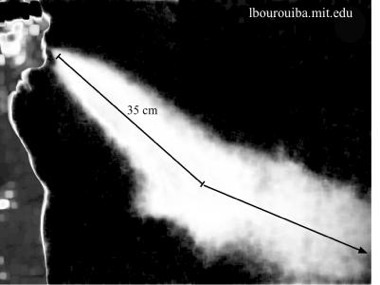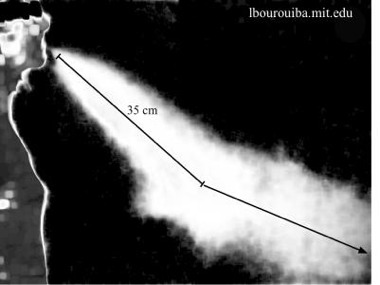MIT scientists have captured high-speed video of phlegm being expelled during a sneeze. It’s as gross as you’d imagine. But learning more about how this mix of saliva and snot breaks into droplets, and spreads far and wide, could one day lead to better strategies for controlling the spread of disease outbreaks.
Sneezing is a natural reflex designed to help the body get rid of invading pathogens, but sneezes can also help spread disease — everything from the common cold to serious stuff like measles or SARS — via droplets that serve as carriers for microorganisms like viruses. These droplets then get deposited, with their infectious cargo, in the air or on surfaces, just waiting for an unsuspecting passerby to breathe in or touch the surface, thereby becoming infected.
But for a long time, scientists remained in the dark about just how far those droplets can travel after being expelled from the nose. The answer: farther than you think — anywhere from 90cm to a worst-case scenario (via computer simulation) of 8m, according to Lydia Bourouiba, who heads MIT’s Fluid Dynamics of Disease Transmission Laboratory. She reported on her team’s latest findings on how such droplets form and spread this morning at a meeting of the American Physical Society’s Division of Fluid Dynamics in Boston, Massachusetts.
In creating their high-speed videos of people sneezing, the MIT team is carrying on a long tradition dating back to 1894. That’s when Thomas Edison’s assistant, Fred Ott, let himself be filmed by William K.L. Dickson, taking a pinch of snuff and sneezing in response. Clocking in at just five seconds, it was the first motion picture to receive a US copyright. Originally it was played on the kinetoscope (an Edison invention) but thanks to the glory of YouTube, we can all view Ott’s timeless performance:
Bourouiba’s lab made headlines last year with a paper detailing just how complex the dynamics of a sneeze can be. Most researchers had assumed that how far droplets travelled depended on their mass: the bigger the droplet, the farther it can travel. It’s basic Newtonian physics: the larger ones would have more momentum. But the MIT lab’s 2014 high-speed footage showed this view was far too simple. We produce gas clouds when we sneeze, and the droplets (with potential pathogens) are suspended within. That cloud can hold even smaller droplets aloft, enabling them to travel much further than Newton’s equations would typically allow.
Now Bourouiba and her colleagues are back with new findings on how droplets actually form inside that fast-moving cloud we emit when we sneeze, based on high-speed video footage of people sneezing. (Fred Ott used snuff to induce sneezes in his film; the MIT lab found “nose tickling” to be the most efficient method, per Bourouiba.) In the past, scientists assumed that they exit the mouth fully formed and neatly distributed in size; that turns out not to be the case.

Rather, the latest footage showed three distinct phases: the fluid first comes out in sheets, then splits into ligaments, and those ligaments then break apart into droplets once the fluid has exited the body.
This latest work focused on two healthy people sneezing (about 50 times a day, so they were dedicated to the cause). Next up: the team plans to do the same for ailing subjects, with an eye toward figuring out how different pathogens spread via sneeze. There’s a lot of variability, after all: some people sneeze delicately, others just let it rip. Everyone will have a slightly different saliva/mucus mix. And some people may be “super-spreaders”: they may transmit pathogens far more effectively than the average person.
All these variables are likely to influence patterns of transmission in any given population, so the better scientists understand the physics, the better the epidemiological models they can build. And the better architects and engineers can design building ventilation systems to combat the droplets’ spread.
Bourouiba also thinks there may be a possible evolutionary link between why we sneeze and how microorganisms like viruses evolved, because “it’s a fantastic propulsion mechanism” for a virus, allowing it to spread farther, faster. This certainly seems to be the case for plants, based on a paper she published earlier this year. Yes, that’s right: plants can “sneeze” after a fashion, too, but only with the help of raindrops, and by doing so they help spread the fungal parasite known as “rust,” as well as other pathogens, to crops.
So for everyone’s sake, do cover your mouth when you sneeze.
References:
Bourouiba, L. et al. (2014) “Violent respiratory events: on coughing and sneezing,” Journal of Fluid Mechanics 745: 537-563.
Gilet, T. and Bourouiba, L. (2015) “Fluid fragmentation shapes rain-induced foliar disease transmission,” Journal of the Royal Society Interface 12: 20141092
Scharfman, B.E. et al. (2015) “Visualisation of sneeze ejecta: steps of fluid fragmentation leading to respiratory droplets,” Experiments in Fluids [in press].
Techet, A., Scharfman, B., and Bourouiba, L. (2015) “3D spray droplet distributions in sneezes,” Presentation G25.1, 68th Annual Division of Fluid Dynamics meeting, November 23, 2015.
Top video and image: L. Bourouiba et al/MIT. Video of Fred Otto’s sneeze: Library of Congress/Public domain.
